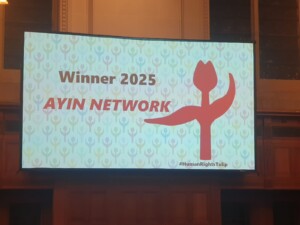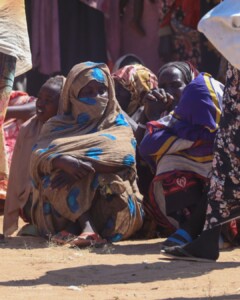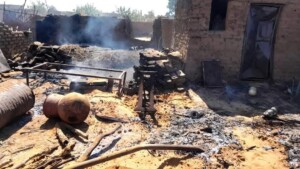Interview with children’s rights activist and fearless journalist Inaam El Tayeb: ‘We were attacked and criminalised by those who rejected our ideas’
For Radio Dabanga’s Inspirational Women Series*, we spoke with children’s rights activist Inaam El Tayeb about her activism, her journalism career, government censorship, and defending children’s rights with her organisation Journalists for Children: “50% of Sudan’s population are children, so it is necessary to focus on them”.
 Children's rights activist and investigative journalist Inaam El Tayeb (RD)
Children's rights activist and investigative journalist Inaam El Tayeb (RD)
For Radio Dabanga’s Inspirational Women Series*, we spoke with Inaam El Tayeb about her activism, her journalism career, government censorship, and defending children’s rights with her organisation Journalists for Children: "Around 50 per cent of Sudan’s population are children, so it is necessary to focus on them".
Inaam Mohamed El Tayeb is Sudan’s most dedicated children’s rights and child issues activist, distinguished by the strength of her determination and her relentless and tireless work on children’s issues, which led to many victories for children’s rights in Sudan. She is also the CEO (Chief Executive Officer) of the Journalists for Children association.
She told us: “I tend to work on community issues, especially those affecting women and children. Children are a particularly vulnerable group, and we must advocate for their cause. 50 per cent of Sudan’s population are children, so it is necessary to focus on them to raise them as strong people that can contribute to building the country and lead it in the future”.
'Children are a particularly vulnerable group, and we must advocate for their cause'
On the basis of that conviction and her experience in the field of journalism, Inaam launched the Journalists for Children association, whose membership so far includes 600 media professionals from different media. The association has achieved clear benchmarks for children’s rights as it worked to integrate the Media Code of Honour on children’s issues into the Press and Publications Act, trained over 400 teachers through the Positive Training Manual that the association developed, and succeeded in including children’s rights in the educational curricula of schools, among other things.
A glimpse of her life
Inaam was born (1962) and raised in Omdurman. She studied at the Abrof Elementary School and High School. She received a bachelor’s degree in journalism and media from Omdurman Islamic University in 1984. She later married fellow journalist Prof Abidin Samsama, who unfortunately passed away, leaving her with three daughters and one son whom she taught and raised well; she is now the mother of two doctors, one English teacher, and a physiotherapist.
Breaking into the press
Inaam started her career in media at the Radio and Television Corporation in the mid-1980s as a producer for the news programme Jareedat El Misa (‘the evening newspaper’) and as a contributing editor in the corporation’s politics department.
However, a strong and urgent desire to work in journalism prompted Inaam and two of her colleagues to storm the El Ayam (The Days) newspaper office on a day in the mid-second half of the 1980s to ask for work.
She said: “Together with my colleagues Sabah and Awatef, we decided to break into El Ayam newspaper and meet the then Editor-in-Chief Mr Hassan Sati. He opened the door wide and welcomed us to work for a trial period of 3 months. The next morning, he wrote a news story about us, and it was published in the paper with a picture as ‘new generations storming the Sudanese press!’”
“I was placed at the Department of Investigations, where I started my journalistic career. I worked with love and enjoyment and achieved things I never dared to dream of in such a short period of time, and I was appointed as a staff member after only a month and a half.”
‘A new form of fraud’ was the title of a small news article Inaam wrote that motivated her to work in journalism that serves the community. She explains: “I wrote about theft at an electronic hardware store on El Jumhuriya Street. The owner of a nearby hotel suspected that the stolen goods were brought to one of the rented rooms. A day later, the thieves were exposed and arrested thanks to the news article”.
'My biggest motivation was the feeling of helping people'
“I was awarded a month’s salary as an incentive, but my biggest motivation was the feeling of helping people. So, it increased my desire to work in journalism and believe in it as something that can serve the community.”
Inaam is also one of the founders of the social magazine El Ashiga (The siblings), first published in 1988. She and her colleague Faiza Shaukat co-founded Azza (Dignity) magazine in the nineties. She later worked for El Siyasa (Politics) newspaper for two years and then rejoined El Ayam newspaper between 2000 and 2006 as head of the investigations department.
In 2006, El Tayeb left El Ayam to work for El Sudani newspaper as head of the investigations department until 2013. She also presented more than 45 episodes of The Lives of the People on children’s issues, a part of the Our House programme that is presented every Saturday and Tuesday.

Prioritising children’s issues
Inaam has always worked to serve humanity and society, her dedication to children’s issues has been evident since the start of her journalistic career as it was the most frequent topic in her distinguished investigations.
‘Homeless Girls’ was one of her first serious investigations for El Ayam newspaper, and it was achieved great success. The field investigation revealed many shocking facts about the lives of these young girls living above and below the streets of Khartoum inside the sewers.
Inaam’s investigations into children’s cases have not only revealed previously unknown facts about children in difficult situations but also played an important role in securing these children’s victories for their rights in the form of official decisions that have changed the course of their tortuous situation. Here, the investigation she conducted on children riding camels in races in the Gulf while working for El Ayam stands as a witness, as it led to a number of political decisions.
Inaam recalls: “The investigation started on the basis of on information about a group of brokers and lawyers who exploited children from poor families. They paid families a sum of money, falsified the identification papers of mostly very young children, and sent them to the United Arab Emirates to be used in camel racing.”
“In response to the publication, I was investigated for two hours by security agents. They then raided the office of the concerned group and arrested the involved brokers and lawyers. All children were recovered from the UAE. Among them were children who had grown up there, some of whom were originally abducted and had been reported as missing. Painfully, some did not recognise their parents anymore.”
'We were attacked, injured, and criminalised by those who rejected our ideas'
The activist journalist also worked specifically on girls’ rights. “For years, I worked on the issue of girls’ circumcision in various media. We were attacked, injured, and criminalised by those who rejected our ideas until article 141 of the Criminal Code was passed 15 years later, which criminalised and prohibited Female Genital Mutilation (FGM).”
‘Execution of a People’ was another important investigation, into the cough syrup drug Sedofan that caused harm to dozens of children. Her investigation prompted the launch of the Consumer Protection Association, which was able to protect thousands of children convincing the Ministry of Health to prohibit the medicine.
A bold investigator
Known as a bold and confrontational investigator, Inaam had to courageously fight many battles to reveal the facts and stick to her positions, including battles with the government, its security services, and the management of the El Sudani newspaper.
She told us that "the investigation ‘Execution of the People’ was one of the most important investigations" but also mentioned the severe backlash she faced on another investigation.
'They threatened me and the newspaper’s management with closure if the publication was not stopped'
"I was summoned directly by the Minister of Cabinet Affairs Kamal Abdellatif because of my reporting on the import of beating devices supplied by the brother of President Omar Al Bashir. I was interrogated for hours in the Council of Ministers and I was put in a helicopter that flew me to where the equipment was used is in the states. I refused because I did not have documents in my hand and what I saw with my eyes was enough. They threatened me and the newspaper’s management with closure if the publication was not stopped. I did not comply despite the pressures of the editor-in-chief at the time.”
The newspaper faced backlash due to its strong and disturbing investigations, so Inaam was fired after she published an investigation into deforestation for the purpose of building a dam.
After her time at the newspaper, Inaam worked for the National Council for Child Welfare in the field of media and advocacy for children’s issues. In 2015, she started to work full-time for her Journalists for Children Association.

Journalists for Children
Its establishment of the association in 2002 was an extension of Inaam’s work in the field of journalism and the result of her fact-finding missions that expose realities that children face and the protection they require.
Journalists for Children now has about 600 media professionals in various media. The association aims to advocate for children’s issues in the media, spread awareness of children’s rights, and make conventions and treaties on these rights a reality. The organisation also aims to involve children in discussions.
Among other things, the association trains media professionals to advocate for children’s causes and combat violence against them. It has also drawn up a Media Code of Honour to deal with children’s issues, which is included in the Press and Publications Act.
Some of the most important things that the association succeeded in were the inclusion of the rights of the child in the educational curricula to inform students about their rights and how to defend them and the education of families on children’s rights through the various media.
Combatting corporal punishment
The association also issued a regulation of conduct control in educational institutions, which was submitted to the Minister of Education, and a decree to prevent corporal punishments in schools.
According to Save the Children International (SCI), corporal punishment is widespread in Sudanese schools and “this behaviour is practised by schoolteachers for educational purposes”.
The Journalists for Children led the work of forming a committee of advisers from the Ministry of Justice and the National Council for Child Welfare, supported by SCI, to set up this regulation of conduct control in educational institutions under the provisions of Article 5 (2) and Article 29 (2) of the Children's Act 2010.
'Teachers should be trained in alternatives to beating'
“Passing these is a great victory for children's rights,” Inaam told SCI. “We have been advocating for this issue for a long time. This regulation puts an end to physical and psychological violence against children in Khalawi, kindergartens, and schools. Hence, teachers should be trained in alternatives to beating. This will be our focus in the coming phase.”
This year, Journalists for Children will promote and implement the new regulations by training teachers on educational alternatives to corporal punishment. They also work to set up advocacy groups to end corporal punishment in schools and to raise public awareness about the problem.

Child-friendly budgets
One of the association’s priorities has been to advocate for the importance of investment in children and governmental budgets for children. The organisation has demanded ‘child-friendly’ budgets to enhance children’s rights.
On their website, Inaam explained that child marriage doubled in past years and that financial resources are often an obstacle to children’s projects and child welfare.
Journalists for Children has developed a plan to allocate a specific budget for children’s issues within the government budget to meet the urgent needs of children.
“Budgeting for children is closely linked to the concept of child-friendliness as part of determining the aggregate measure of overall government commitment towards its children”, journalists for Children writes on their website.
“We organised training workshops to advocate for child-friendly budgets and we sat down with the Cabinet and the Ministry of Finance to formally implement the budget, and we found a great response,” Inaam explained.
Displacement and child labour
The association also worked on the topic of child labour in cooperation with UNICEF, providing children with the opportunity to study by opening classes after 12 o-clock in, what are known as, ‘child-friendly schools’.
‘The Association for the Displaced’ is another special partnership with the Sabah Organisation and the National Council for Child Welfare. On a visit to Cairo, the association was briefed on the conditions of Sudanese refugees in Egypt: “We found that the children’s conditions were very bad, so we started this process with the Passport and Foreign Affairs Department to help bring these kids back to the country”.
The Journalists for Children association has sought other external partnerships and has had partnerships with the Women’s Club, the Motherhood and Childhood Organisation in Egypt, and several of the association’s journalists have been trained in Cairo.
Journalists for Children also issues a monthly publication called “Amana”, which is distributed free of charge to children. It further plans to launch a children’s radio and television programme.
* More from the Inspirational Women series:
Interview with Awadiya Abbas: Women’s union organiser and revolutionary
Interview with novelist Sara El Jak on literature, womanhood, and empowerment
Interview with Nuba Kandaka Safaa Tutu: A Story of Resilience and Struggle
Interview with Nisreen El Saim: The December Revolution's Kandaka and a global climate activist











 and then
and then